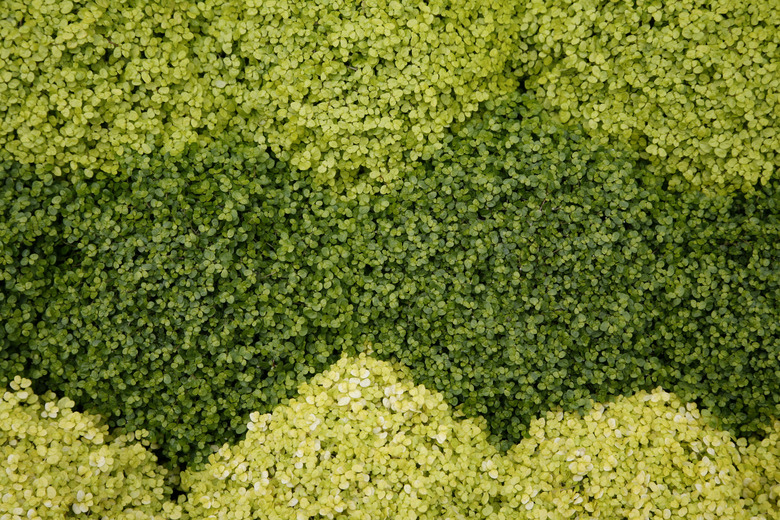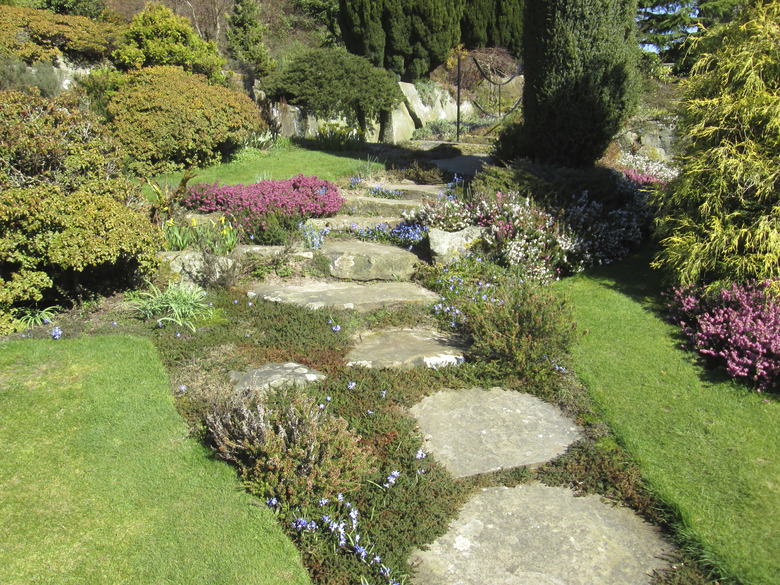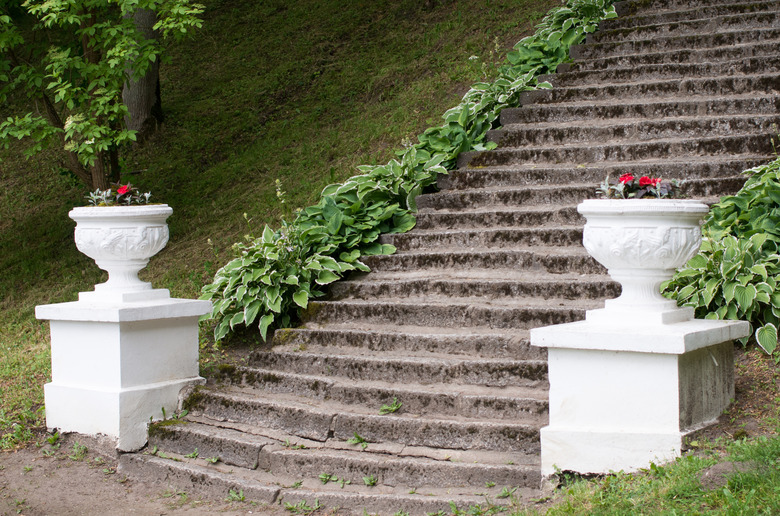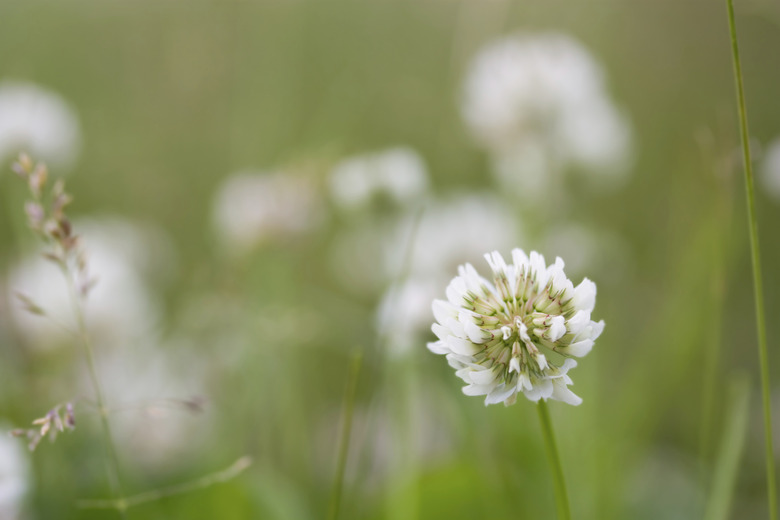Ground Cover Plants For High-Traffic Areas
High-traffic garden areas are places where people tread three or four times or more often per day, such as the gaps between stepping stones, green pathways, lawns made of ground cover plants, and the edges of beds and borders where children or pets frequently play. Plants that grow best in these areas include low-growing, spreading plants with tough stems and leaves. Vigorous ground cover plants that quickly regrow after suffering damage also perform well in high-traffic areas, though sometimes these plants are invasive.
Warm Climates
Baby's tears (Soleirolia soleirolii) offers tiny, rounded leaves and small, star-shaped, white early summer flowers. Hardy in U.S. Department of Agriculture plant hardiness zones 8a through 11, this semi-evergreen plant grows 1 to 3 inches tall, and spreads quickly to 6 to 12 inches wide, forming a lush, dense mat. Baby's tears tolerates most light conditions, from full sun to full shade.
Brass buttons (Leptinella squalida) features fernlike, oval, soft-textured leaves 2 inches long and 1/2 inch wide, and is hardy in USDA zones 4 through 10. Growing 2 inches tall and 3 to 12 inches wide, or indefinitely in good growing conditions, brass buttons is evergreen in warm zones and deciduous in cold areas.
Cool Zones
Miniature brass buttons (Leptinella gruveri) grows 1 inch tall and spreads 8 to 12 inches wide, creating a carpet of tiny evergreen leaves, and grows well in full-shade to partial-shade areas. In summer, tiny greenish flowers appear.
**Corsican mint (**Mentha requienii**)** offers a pleasant aroma as well as a mat of bright green leaves 1 inch tall and 6 to 12 inches wide. When the leaves are crushed, they release a creme-de-menthe scent. Corsican mint grows best in evenly moist soil and partially shaded spots. It can be invasive but because it spreads above ground and not through underground runners, it's easy to control. **
**
Miniature brass buttons and Corsican mint are hardy in USDA zones 7 through 9.
Cold Areas
'Heavenly Blue' harebell speedwell (Veronica rupestris 'Heavenly Blue') features low-growing, dense foliage and sapphire**-**blue spring blooms. This perennial plant grows 1 to 4 inches tall and quickly spreads up to 24 inches wide. Hardy in USDA zones 4 through 9, 'Heavenly Blue' grows best in sunny spots.
**Wild thyme 'Elfin'** (Thymus serpyllum 'Elfin') is hardy in USDA zones 4 through 8 and provides tiny, lavender pink, summer flowers. Growing 3 inches tall and 12 to 18 inches wide, 'Elfin' also offers small, rounded, gray green leaves and is another sun lover.
Very Cold Regions
**Caucasian stonecrop 'John Creech'** (Sedum spurium 'John Creech'), which is hardy in USDA zones 3 through 8, grows 2 inches tall and forms a spreading mat by producing roots where its stem touch the ground. The leaves are thick and succulent and medium green with reddish-tinged margins. Pink blooms appear in fall. Growing best in sunny spots, 'John Creech' also tolerates partial shade.
Clover (Trifolium repens) is considered by some to be a lawn weed, but it provides an effective ground cover in high-traffic areas of the garden. Hardy in USDA zones 3 through 10, clover grows 4 inches tall and 12 inches wide or wider, and offers its characteristic three-leaved stems and globe-shaped, white spring flowers. Preferring partial shade, clover also tolerates full-sun growing areas.
Plants Used For Ground Cover
Areas exposed to hot summer sun dry out quickly, creating drought-like conditions for plants growing in the area. These plants do not grow well when the soil dries out. All summer, this plant is covered in small fragrant cream-colored blossoms that attract birds to the garden. Serbian bellflower (Campanula poscharskyana) grows as a perennial in USDA zones 3 through 8, reaching 12 inches tall and spreading 18 inches wide. Shady dry areas are commonly found under tall shrubs or trees where rainwater does not reach. You can install "Auslese" lady's mantle (Alchemilla mollis "Auslese"), which grows gray-green scalloped leaves with green summer flowers. The mass of leaves hides the brown-purple spring flowers. This plant, which prefers morning sun and afternoon shade, grows less than 6 inches tall, spreading 6 to 12 inches wide. "
- Areas exposed to hot summer sun dry out quickly, creating drought-like conditions for plants growing in the area.
- All summer, this plant is covered in small fragrant cream-colored blossoms that attract birds to the garden.
Warning
Aggressive spreading can be a problem with baby's tears. and brass buttons. Though the plants can be pulled up, any piece left behind can grow into a new plant.
Tip
For the best results, select ground cover plants that thrive in the available light. Plants that grow best in full-sun or sunny spots need at least six hours of direct sunlight per day, and partial-sun plants need four to six hours of sunlight per day. Plants for partial shade grow well in two to four hours of sunlight, and full-shade plants thrive in little or no direct sunlight.
References
- California Invasive Plant Council: Ground Covers of the Bay Area Region
- Monrovia: Miniature Stonecrop
- Monrovia: Taylortown Red Verbena
- Monrovia: Asian Star Jasmine
- Missouri Botanical Garden: Campanula Poscharskyana
- Monrovia: "Auslese" Lady's Mantle
- Fine Gardening: Lamium Galeobdolon "Hermann's Pride" (Deadnettle, Yellow Archangel)
- Fine Gardening: Asarum Shuttleworthii (Evergreen Wild Ginger)
- Monrovia: "Green Sheen" Japanese Spurge



